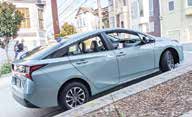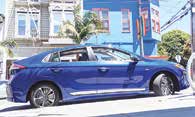
By Philip Ruth–
How are you holding up in this pandemic? Going a little nuts in your home like I am? You probably are, and the somnolence that results from excess solitude seems to ratchet up as the months pass and the economic growth shrivels.
The automotive sector has not suffered like so many others have. My mechanic is jammed with clients, and new-car dealers that actually have a decent stock from which to choose—many don’t, as production has slowed—are dealing.
Classic cars are also sparse, as general uncertainty has sellers holding onto their assets. But there’s one type of car that’s plentiful in the used-car listings: the economical commuter. With so many newly-minted home-bound workers, the supply of hybrids and mid-sized sedans that once ferried project managers to Palo Alto is bursting.

The two hybrids we’re examining today populate that market in large numbers. The Toyota Prius needs no introduction, and it has surprised us all by making its wild styling blend in with the crowd. Even with all of its adventurous squints and angles, the ubiquity of Priuses in the Bay Area means it nearly goes unseen.

The Hyundai finds its footing as a more conservative alternative. The Ioniq’s worn-soap-bar look is a relief to behold after absorbing the Prius’ dramatic cutline collisions.
It should be said that Toyota has many Prius buyers already locked up, which makes academic most comparisons with the Hyundai. Prius owners are among the happiest and most loyal of all. It’s a car with a golden reputation built over two decades. Its core buyers would consider a Hyundai as soon as never.
That’s a shame, because the Ioniq has two notable advantages. First is visibility; the Prius places you low behind the dashboard, the lines of which begin in the door panels and swell up around and in front of you. Some drivers like having plenty of plastic structure around them, for an added sense of safety, and the Prius delivers that.
The Ioniq sits you high behind a lower dashboard, which imparts to the driver a more commanding feeling. This sets you up to exploit the Ioniq’s extra agility that becomes clear the instant you accelerate. The key is the Ioniq’s six-speed, dual-clutch transmission, which locks into the torque you’ve requested and shunts it down to the wheels. The Prius has a CVT transmission that evinces a rubbery response. Compared to the Ioniq’s gears, it feels elastic and indirect.
The passivity perpetuated in the Prius’ performance is a likely complement to its comfort. Seats are supportive, and they stuff lots of mush under your tush. The Ioniq’s thinner cushions are firmer, which was appreciated as I explored the limits of its stiffer-than-Prius suspension.
I was surprised by how natural it was to drive the Ioniq with enthusiasm, like it was a hybrid muscle car, just as I was happy to tootle along in the middle lane in the Prius’ cave-like environs. Both hybrids deserve a look—both at the dealer and from former commuters.
Philip Ruth is a Castro-based automotive photojournalist and consultant with an automotive staging service.
Published on August 13, 2020
Recent Comments